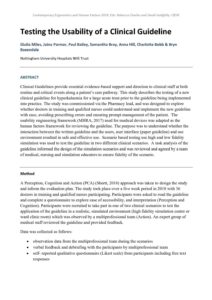| Document | Author Giulia Miles, Jaina Parmar, Paul Bailey, Samantha Bray, Anna Hill, Charlotte Bebb & Bryn Baxendale |
| Abstract Clinical Guidelines provide essential evidence-based support and direction to clinical staff at both routine and critical events along a patient’s care pathway. This study describes the testing of a new clinical guideline for hyperkalaemia for a large acute trust prior to the guideline being implemented into practice. The study was commissioned via the Pharmacy lead, and was designed to explore whether doctors in training and qualified nurses could understand and implement the new guideline with ease, avoiding prescribing errors and ensuring prompt management of the patient. The usability engineering framework (MHRA, 2017) used for medical devices was adapted as the human factors framework for reviewing the guideline. The purpose was to understand whether the interaction between the written guideline and the users, user interface (paper guideline) and use environment resulted in safe and effective use. Scenario based testing use high and low fidelity simulation was used to test the guideline in two different clinical scenarios. A task analysis of the guideline informed the design of the simulation scenarios and was reviewed and agreed by a team of medical, nursing and simulation educators to ensure fidelity of the scenario. |

